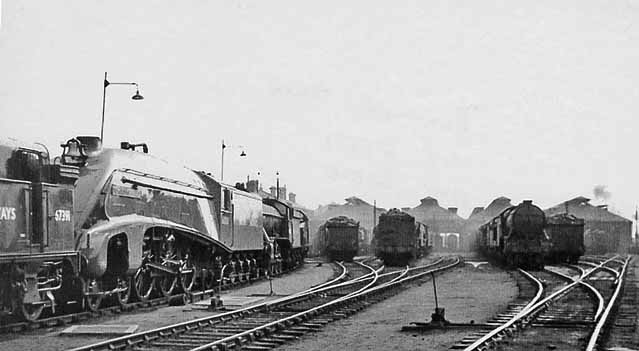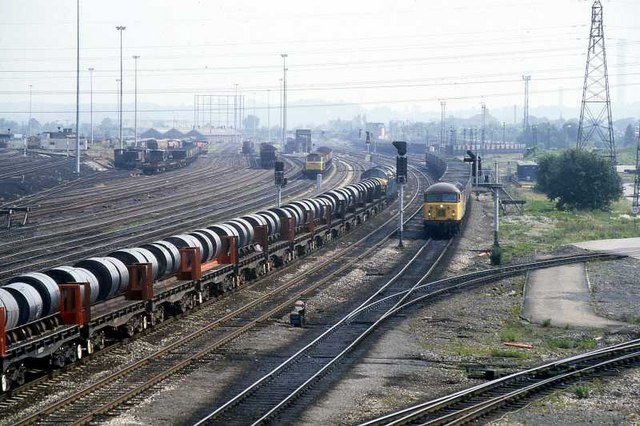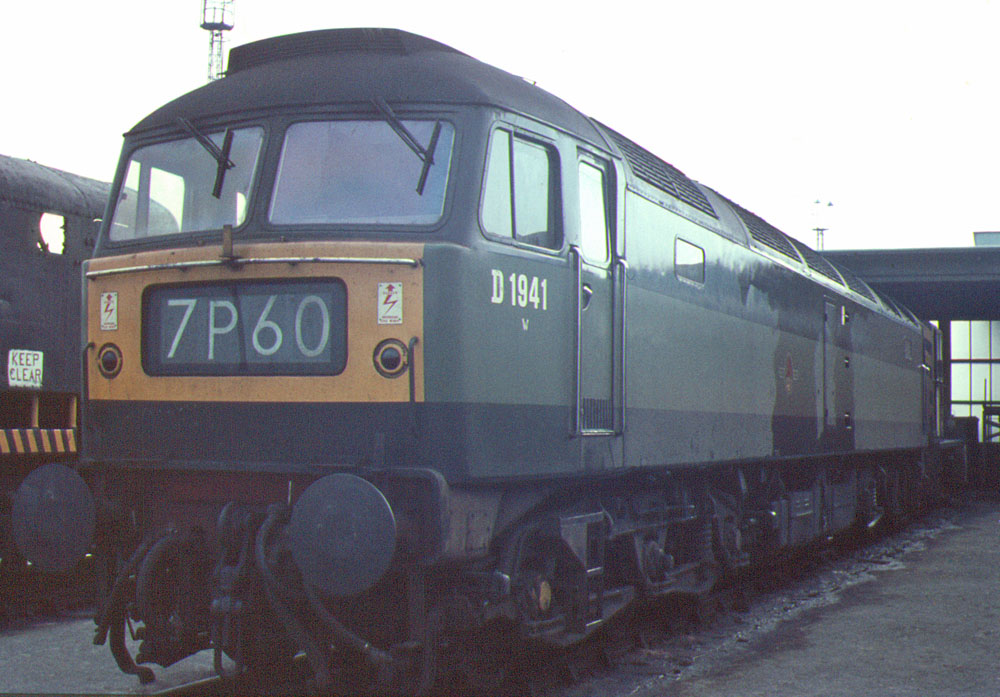|
Tinsley Motive Power Depot
Tinsley Motive Power Depot, latterly Tinsley Traction Maintenance Depot ( TMD), was a railway depot in Tinsley, South Yorkshire, near Sheffield. Access by road was from Brinsworth, near Rotherham. The depot was situated on the freight line between Treeton Junction and the A631 Shepcote Lane. History The depot was built as part of the Sheffield district rail rationalisation plan of the 1960s opening in April 1964 replacing Millhouses, Grimesthorpe, Darnall and Canklow steam sheds. It was situated adjacent to, but at a higher level than, the new Tinsley Marshalling Yard alongside the Sheffield District Railway. Diesel locomotives had been stationed at the old steam shed at Grimesthorpe until the new facilities were completed and the locomotives were moved to their new home. The site also included a small electric locomotive servicing shed at the south end of the Secondary Yard, replacing the facilities at Darnall. Diesel railcars, which had been serviced at Darnall, were moved ... [...More Info...] [...Related Items...] OR: [Wikipedia] [Google] [Baidu] |
Tinsley, South Yorkshire
Tinsley is a suburb of north-eastern Sheffield, South Yorkshire, England; it falls within the Darnall ward of the city. The area is associated with: * The former Tinsley Marshalling Yard, which was used between 1965 and 1998 to separate railway wagons from incoming freight trains and add them to new trains. * The former Tinsley railway maintenance depot between 1964 and 1998; at its peak, 200 locomotives were allocated here. * The former Tinsley Towers. * Tinsley Viaduct, which carries the M1 motorway across the Don Valley. History The name of the suburb derives from the Old English ''Tingas-Leah'', which means 'Field of Council', cognate with "thing (assembly)" and "lea", a dialectal word for "meadow". It is mentioned as 'Tirneslawe' or 'Tineslawe' in the Domesday Book of 1086 when it was in the possession of Roger de Busli. The chapel of St Lawrence, Tinsley was built in 1877 on the site of an ancient (possibly of Anglo-Saxon origin) chapel. Wood, Michael (2001). Tinsley ... [...More Info...] [...Related Items...] OR: [Wikipedia] [Google] [Baidu] |
The Railway Magazine
''The Railway Magazine'' is a monthly British railway magazine, aimed at the railway enthusiast market, that has been published in London since July 1897. it was, for three years running, the railway magazine with the largest circulation in the United Kingdom, having a monthly average sale during 2009 of 34,715 (the figure for 2007 being 34,661). It was published by IPC Media until October 2010, with , and in 2007 won IPC's 'Magazine of the Year' award. Since November 2010, ''The Railway Magazine'' has been published by Mortons of Horncastle. History ''The Railway Magazine'' was launched by Joseph Lawrence and ex-railwayman Frank E. Cornwall of Railway Publishing Ltd, who thought there would be an amateur enthusiast market for some of the material they were then publishing in a railway staff magazine, the ''Railway Herald''. They appointed as its first editor a former auctioneer, George Augustus Nokes (1867–1948), who wrote under the pseudonym "G. A. Sekon". He quickly bui ... [...More Info...] [...Related Items...] OR: [Wikipedia] [Google] [Baidu] |
Rail Express
This tabulation is for periodicals which do not have their own articles. Magazines ''Australian Railway'' * * Published Trade News Corporation * Feb-Mar 1988 is Vol. 2 No. 1. * Last issue about #23 in approximately Aug 1992. * Size = ~A4 ''Australian Railways Illustrated'' * * Bi-monthly * Published April 2010 - April 2015 * Size = ~A4 ''Australian Transport'' * * Published Chartered Institute of Logistics & Transport, Australian chapter * Published 1952 - 1992 * Size = A4 ''British Railways Illustrated'' * * published by Irwell Press; Clophill * first issue: Oct 1991, freq: monthly, Vol 26 No 1 = Oct 2016 * Size A4 * http://www.irwellpress.com/acatalog/BRITISH_RAILWAYS_ILLUSTRATED.html ''Catch Point Magazine'' * * Published by the National Railway Museum, Port Adelaide * Issue : July 2014 is Issue 222. * Size : A5. * Web : www.natrailmuseum.org.au * Email : info@natrailmuseum.org.au ''Entrain'' * * Published by Platform 5 Publishing, Sheffield ... [...More Info...] [...Related Items...] OR: [Wikipedia] [Google] [Baidu] |
Crewe Electric TMD
Crewe Electric TMD (officially named Crewe IEMD – International Electric Maintenance Depot) is a traction maintenance depot for AC electric and diesel-electric locomotives. It is situated to the north-west of Crewe railway station on the Crewe to Chester railway line, opposite Crewe Works. Road access is from Wistaston Road and the depot is operated by DB Cargo UK. Starting in 1987, when Railfreight introduced depot plaques on its locomotives. Locomotives allocated to Crewe IEMD carried a plaque depicting an Eagle. References Rail Atlas Great Britain & Ireland, S.K. Baker Further reading * * External links *Depot DirectorWest Coast (Internet Archive)*Aoverhead viewof the depot. Crewe Works Crewe Works is a British railway engineering facility located in the town of Crewe, Cheshire. The works, which was originally opened by the Grand Junction Railway in 1840, employed around 7,000 to 8,000 workers at its peak. In the 1980s, a lot ... is the long, rectangular building ... [...More Info...] [...Related Items...] OR: [Wikipedia] [Google] [Baidu] |
Doncaster Carr Rail Depot
Doncaster Carr rail depot (also known as Doncaster Train Maintenance Centre) is a railway vehicle maintenance depot located alongside the East Coast Main Line in Doncaster, England. It is presently operated by Hitachi as part of their contract to maintain the AT300 units for London North Eastern Railway and TransPennine Express. The original facility Doncaster Locomotive depotAlso known as Doncaster Carr Motive Power Depot, Doncaster Carr shed was a major 12 road steam locomotive maintenance shed built by the Great Northern Railway (GNR) in 1876. The shed remained in use under the successor companies London and North Eastern Railway and British Railways, being significantly modified in the mid 1950s; steam locomotive use at the shed ended in the 1960s. Until the facility was selected as a maintenance depot for the new AT300 fleet, the depot was used for diesel locomotive maintenance. Site history Doncaster Carr locomotive shed (1876–2014) By the 1850s the Great North ... [...More Info...] [...Related Items...] OR: [Wikipedia] [Google] [Baidu] |
Bescot TMD
Bescot TMD is a locomotive traction maintenance depot in the West Midlands (county), West Midlands, England. Situated adjacent to Bescot Stadium railway station, Bescot Stadium station, the depot with code BS is currently operated by DB Schenker Rail (UK). Bescot Yard is to the south-east of the depot. This entire complex of track is clearly visible from the northern end of the M6 motorway, M6 and M5 motorway, M5 motorway junction. History The line via Aston, Perry Barr and Bescot is the former Grand Junction Railway, opened in 1837. The section between Walsall and Cannock was constructed by the South Staffordshire Railway. The section between Cannock and Rugeley was constructed by the Cannock Mineral Railway. Bescot Yard was opened to handle coal and goods traffic in the Birmingham area, and so needed a depot to provide and service a wide range of locomotives. After the LMS took over in 1923, the List of British Railways shed codes, shed code became 3A. The shed was rebuilt as a ... [...More Info...] [...Related Items...] OR: [Wikipedia] [Google] [Baidu] |
Toton TMD
Toton Traction Maintenance Depot or Toton Sidings is a large traction maintenance depot located in Toton, Nottinghamshire. The TOPS depot code for the depot is TO. Before TOPS, the shed code was 16A (18A prior to 1963). Prior to the 2021 Integrated Rail Plan for the North and Midlands, the site was the proposed location of the East Midlands Hub railway station on the Leeds Branch of HS2. History The history of the development of Toton is highly associated with the history, development and decline of the coal industry in England. The Midland Railway had developed the Midland Main Line from the 1860s, and had a developing revenue from coal traffic from both the Yorkshire and Nottinghamshire coalfields to the power stations of the industrialised West Midlands. This traffic was added to by the fact that most towns also had their own gasworks, with coal delivered by rail to their own private sidings, and the rapidly developing domestic use of coal for heating and cooking. With nee ... [...More Info...] [...Related Items...] OR: [Wikipedia] [Google] [Baidu] |
Channel Tunnel
The Channel Tunnel (french: Tunnel sous la Manche), also known as the Chunnel, is a railway tunnel that connects Folkestone (Kent, England, UK) with Coquelles ( Hauts-de-France, France) beneath the English Channel at the Strait of Dover. It is the only fixed link between the island of Great Britain and the European mainland. At its lowest point, it is deep below the sea bed and below sea level. At , it has the longest underwater section of any tunnel in the world, and is the third longest railway tunnel in the world. The speed limit for trains through the tunnel is . The tunnel is owned and operated by the company Getlink, formerly "Groupe Eurotunnel". The tunnel carries high-speed Eurostar passenger trains, the Eurotunnel Shuttle for road vehicles and international freight trains. It connects end-to-end with the high-speed railway lines of the LGV Nord in France and High Speed 1 in England. In 2017, through rail services carried 10.3 million passengers and 1.22 milli ... [...More Info...] [...Related Items...] OR: [Wikipedia] [Google] [Baidu] |
DB Cargo UK
DB Cargo UK (formerly DB Schenker Rail UK and English, Welsh & Scottish Railway (EWS)), is a British rail freight company headquartered in Doncaster, England. The company was established in early 1995 as ''North & South Railways'', successfully acquiring and merging five of the six freight companies that were sold during the privatisation of British Rail,The sixth rail freight company created during privatisation, Freightliner, was privatised through a management buyout. On 25 April 1996, the EWS brand was revealed and implemented over successive months. By the end of March 1997, it controlled 90% of the UK rail freight market, operated a fleet of 900 locomotives and 19,000 wagons, and had 7,000 employees. During the late 1990s, EWS invested heavily into rolling stock renewal, procuring a large number of British Rail Class 66 diesel locomotives, headcount was also reduced. It also acquired National Power's open-access freight operator in April 1998. During January 2001, the ... [...More Info...] [...Related Items...] OR: [Wikipedia] [Google] [Baidu] |
British Rail Class 47
The British Rail Class 47 or Brush Type 4 is a class of diesel-electric locomotive that was developed in the 1960s by Brush Traction. A total of 512 Class 47s were built at Brush's Falcon Works in Loughborough and at British Railways' Crewe Works between 1962 and 1968, which made them the most numerous class of British mainline diesel locomotive. They were fitted with the Sulzer 12LDA28C twin-bank twelve-cylinder unit producing though this was later derated to to improve reliabilityand have been used on both passenger and freight trains on Britain's railways for over 55 years. Despite the introduction of more modern types of traction, a significant number are still in use, both on the mainline and on heritage railways. As of December 2021, 78 locomotives still exist as Class 47s, including 31 which have been preserved. 33 further locomotives were converted to Class 57s between 1998 and 2004. Origins The Class 47 history begins in the early 1960s with the stated aim of ... [...More Info...] [...Related Items...] OR: [Wikipedia] [Google] [Baidu] |
Privatisation Of British Rail
The privatisation of British Rail was the process by which ownership and operation of the railways of Great Britain passed from government control into private hands. Begun in 1994, it had been completed by 1997. The deregulation of the industry was initiated by EU Directive 91/440 in 1991, which aimed to create a more efficient rail network by creating greater competition. British Railways (BR) had been in state ownership since 1948, under the control of the British Railways Board (BRB). Under the Conservative government of Margaret Thatcher elected in 1979, various state-owned businesses were sold off, including various functions related to the railways – Sealink ferries and British Transport Hotels by 1984, Travellers Fare catering by 1988 and British Rail Engineering Limited (train building) by 1989. It was under Thatcher's successor John Major that the railways themselves were privatised, using the Railways Act 1993. The operations of the BRB were broken up and sold o ... [...More Info...] [...Related Items...] OR: [Wikipedia] [Google] [Baidu] |







